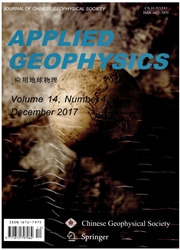

 中文摘要:
中文摘要:
在自然界中地层会呈现出各向异性特征,各向异性介质的研究有助于资料解释和认识地球动力学的过程,但当前数据处理中多数使用各向同性理论解释各向异性构造,因而对电磁资料解释造成了一定的偏差。当前,时间域航空电磁法关于各向异性的解释仍局限于一维情况,且相应的三维数值模拟也正处于研究中,因此本文针对任意各向异性介质中三维时间域航空电磁法进行正演模拟。将各向同性介质的电导率经过坐标旋转后,得到任意各向异性介质的电导率张量,将其引入到麦克斯韦方程组中,采用矢量有限元法的规则网格对求解区域进行剖分,利用直接求解器对总体合成的线性方程组进行求解。通过与解析解对比,验证了算法的精确性和可行性;同时与各向同性情况进行对比,通过响应的分布特征及幅值变化分析任意各向异性对三维时间域航空电磁响应的影响,得出在不同情况下各向异性对时间域航空电磁响应的影响情况存在较大差异。
 英文摘要:
英文摘要:
Electrically anisotropic strata are abundant in nature, so their study can help our data interpretation and our understanding of the processes of geodynamics. However, current data processing generally assumes isotropic conditions when surveying anisotropic structures, which may cause discrepancies between reality and electromagnetic data interpretation. Moreover, the anisotropic interpretation of the time-domain airborne electromagnetic (TDAEM) method is still confined to one dimensional (1D) cases, and the corresponding three-dimensional (3D) numerical simulations are still in development. In this study, we expanded the 3D TDAEM modeling of arbitrarily anisotropic media. First, through coordinate rotation of isotropic conductivity, we obtained the conductivity tensor of an arbitrary anisotropic rock. Next, we incorporated this into Maxwell's equations, using a regular hexahedral grid of vector finite elements to subdivide the solution area. A direct solver software package provided the solution for the sparse linear equations that resulted. Analytical solutions were used to verify the accuracy and feasibility of the algorithm. The proven model was then applied to analyze the effects of arbitrary anisotropy in 3D TDAEM via the distribution of responses and amplitude changes, which revealed that different anisotropy situations strongly affected the responses of TDAEM.
 同期刊论文项目
同期刊论文项目
 同项目期刊论文
同项目期刊论文
 期刊信息
期刊信息
